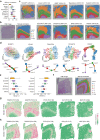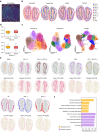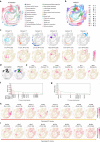PROST: quantitative identification of spatially variable genes and domain detection in spatial transcriptomics
- PMID: 38238417
- PMCID: PMC10796707
- DOI: 10.1038/s41467-024-44835-w
PROST: quantitative identification of spatially variable genes and domain detection in spatial transcriptomics
Abstract
Computational methods have been proposed to leverage spatially resolved transcriptomic data, pinpointing genes with spatial expression patterns and delineating tissue domains. However, existing approaches fall short in uniformly quantifying spatially variable genes (SVGs). Moreover, from a methodological viewpoint, while SVGs are naturally associated with depicting spatial domains, they are technically dissociated in most methods. Here, we present a framework (PROST) for the quantitative recognition of spatial transcriptomic patterns, consisting of (i) quantitatively characterizing spatial variations in gene expression patterns through the PROST Index; and (ii) unsupervised clustering of spatial domains via a self-attention mechanism. We demonstrate that PROST performs superior SVG identification and domain segmentation with various spatial resolutions, from multicellular to cellular levels. Importantly, PROST Index can be applied to prioritize spatial expression variations, facilitating the exploration of biological insights. Together, our study provides a flexible and robust framework for analyzing diverse spatial transcriptomic data.
© 2024. The Author(s).
Conflict of interest statement
The authors declare no competing interests.
Figures




Similar articles
-
Benchmarking computational methods for detecting spatial domains and domain-specific spatially variable genes from spatial transcriptomics data.Nucleic Acids Res. 2025 Apr 10;53(7):gkaf303. doi: 10.1093/nar/gkaf303. Nucleic Acids Res. 2025. PMID: 40240000 Free PMC article.
-
Evaluating spatially variable gene detection methods for spatial transcriptomics data.Genome Biol. 2024 Jan 15;25(1):18. doi: 10.1186/s13059-023-03145-y. Genome Biol. 2024. PMID: 38225676 Free PMC article.
-
SINFONIA: Scalable Identification of Spatially Variable Genes for Deciphering Spatial Domains.Cells. 2023 Feb 13;12(4):604. doi: 10.3390/cells12040604. Cells. 2023. PMID: 36831270 Free PMC article.
-
Recent advances in spatially variable gene detection in spatial transcriptomics.Comput Struct Biotechnol J. 2024 Feb 2;23:883-891. doi: 10.1016/j.csbj.2024.01.016. eCollection 2024 Dec. Comput Struct Biotechnol J. 2024. PMID: 38370977 Free PMC article. Review.
-
Computational solutions for spatial transcriptomics.Comput Struct Biotechnol J. 2022 Sep 1;20:4870-4884. doi: 10.1016/j.csbj.2022.08.043. eCollection 2022. Comput Struct Biotechnol J. 2022. PMID: 36147664 Free PMC article. Review.
Cited by
-
ST-SCSR: identifying spatial domains in spatial transcriptomics data via structure correlation and self-representation.Brief Bioinform. 2024 Jul 25;25(5):bbae437. doi: 10.1093/bib/bbae437. Brief Bioinform. 2024. PMID: 39228303 Free PMC article.
-
Spatially informed graph transformers for spatially resolved transcriptomics.Commun Biol. 2025 Apr 6;8(1):574. doi: 10.1038/s42003-025-08015-w. Commun Biol. 2025. PMID: 40188303 Free PMC article.
-
Thor: a platform for cell-level investigation of spatial transcriptomics and histology.Res Sq [Preprint]. 2025 Mar 10:rs.3.rs-4909620. doi: 10.21203/rs.3.rs-4909620/v1. Res Sq. 2025. Update in: Nat Commun. 2025 Aug 5;16(1):7178. doi: 10.1038/s41467-025-62593-1. PMID: 40162205 Free PMC article. Updated. Preprint.
-
Systematic inference of super-resolution cell spatial profiles from histology images.Nat Commun. 2025 Feb 21;16(1):1838. doi: 10.1038/s41467-025-57072-6. Nat Commun. 2025. PMID: 39984438 Free PMC article.
-
Thor: a platform for cell-level investigation of spatial transcriptomics and histology.Nat Commun. 2025 Aug 5;16(1):7178. doi: 10.1038/s41467-025-62593-1. Nat Commun. 2025. PMID: 40764306 Free PMC article.
References
MeSH terms
LinkOut - more resources
Full Text Sources

